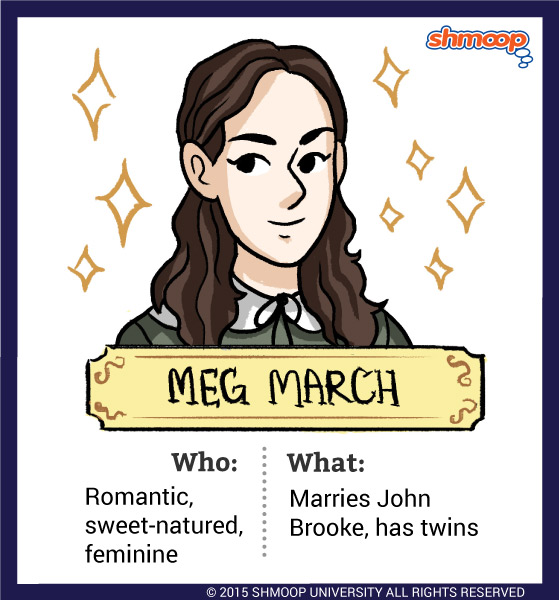Character Analysis

(Click the character infographic to download.)
Meg, short for Margaret, is the oldest and (until Amy grows up) the prettiest of the four March sisters. She's also the most typical of the sisters – we think of her as everything that you might expect a nineteenth-century American girl from a good family to be. Meg loves luxury, nice things, dainty food, and good society. She's the only sister who can really remember when her family used to be wealthy, and she feels nostalgic about those good old days. Her dream is to be wealthy once more, and have a huge mansion with lots of servants and expensive possessions. She's also a bit of a romantic; when she has to tell a story to amuse her sisters, it's about love and marriage, and Jo starts to suspect pretty early on that Meg might have a real-life Prince Charming in her thoughts. Meg is sweet-natured, dutiful, and not at all flirtatious – in fact, she's unrealistically good and proper. Perhaps that's why she's so alarmed by her sister Jo's rambunctious, tomboyish behavior.
Each of the March sisters has at least one major character flaw that she struggles to overcome, and Meg is no different. Meg's problem is, well, avarice. Greed. Envy. Wanting stuff that other people have. Whatever you call it, she's got it in spades. Meg tries to set aside her materialism, and gradually learns to value simple things more because of the hard work that it takes to earn them.
Before she gets to that point, however, she spends many, many hours envying the fortune and leisured life of her friends Sallie Gardiner and the Moffat girls. In fact, at one point Meg allows the Moffats to dress her up in fancy clothes, covering her in makeup and jewelry and making her show far more cleavage than a demure, Protestant, nineteenth-century girl really should. She even – we know you'll be horrified here – drinks champagne at one point! It only takes Meg one bout of this kind of vanity and wealth-worship to realize that the people she's trying to impress are unbelievably shallow. She doesn't feel like herself, and when she hears someone at the party say that she's dressed up like a doll, she realizes that's exactly what she's turned herself into, and she never does it again. Even at her wedding, Meg wears a simple dress that she makes herself by hand.
Oh, did we say "wedding"? (OK, if you haven't finished reading the book, avert your eyes at this point because we might be spoiling something.) Of course Meg, the most traditionally feminine of the sisters, gets married. Her parents force her to wait until she is twenty before committing herself – an unusual step for parents of their time, but the Marches aren't typical in any way. But when Meg does marry, it's not to a wealthy man who can keep her in the style of a Moffat; it's to poor, hard-working, orphaned John Brooke. Meg and John don't have much money, but they do have love. They also have something else that Meg's upbringing has taught her: the Protestant work ethic. Between these two qualities, they do just fine, and Meg soon fulfills the other function of a nineteenth-century woman: producing children. Her twins Daisy and Demi become the newest members of the March family.
Now, we know we're being kind of flippant about Meg's decision to get married, have children, and be a stay-at-home mom and homemaker. We don't mean to suggest that we think this is an easy career path or a cop-out by any means – in fact, at some points in the novel, Meg seems to work the hardest of any of the sisters! The reason we're rolling our eyes is that it's just not a very surprising plot point. All young women in the nineteenth century were expected to get married, have children, and be housewives. In fact, there were very few careers in the public sphere open to women, and the girls who didn't get the chance to follow the same path as Meg were looked down upon. So, while we commend Meg for working hard, we have to look elsewhere in the novel for surprising plot twists.
A note about names: Margaret has two nicknames, "Meg" and "Daisy," both of which were common nicknames for "Margaret" in the nineteenth century. This can be confusing at a few points, especially when Meg has a daughter of her own, names her Margaret, and calls her "Daisy." We also learn that Meg's mother is named Margaret, too – maybe that's why she goes by "Marmee," which sounds halfway between "Mommy" and "Margaret." So there are actually three Margarets, grandmother, mother, and daughter, but they're usually referred to as Marmee or Mrs. March, Meg, and Daisy.